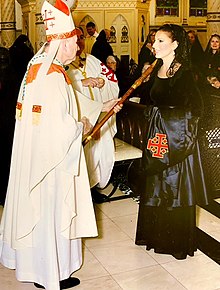Dame

Dameis anhonorifictitle and the feminineform of addressfor the honour ofdamehoodin many Christianchivalric orders,as well as theBritish honours systemand those of several otherCommonwealth realms,such asAustraliaandNew Zealand,with the masculine form of address beingSir.It is the female equivalent of aknighthood,which is traditionally granted to males.[1]Dame is also a style used by baronetessesin their own right.
A woman appointed to the grades of the Dame Commander or Dame Grand Cross of theOrder of Saint John,[2]Equestrian Order of the Holy Sepulchre,[3]Most Honourable Order of the Bath,theMost Distinguished Order of Saint Michael and Saint George,theRoyal Victorian Order,or theMost Excellent Order of the British Empirebecomes a dame.[4]A Central European order in which female members receive the rank of Dame is theImperial and Royal Order of Saint George.[5]Since there is no female equivalent to aKnight Bachelor,women are always appointed to anorder of chivalry.[6]Women who are appointed to theMost Noble Order of the Garteror theMost Ancient and Most Noble Order of the Thistleare given the title ofLadyrather than Dame.[7]
Women receive all their honours in the same fashion as men receiving decorations or medals, even if they are receiving a damehood, so there is no female word equivalent of being "knighted".
History[edit]
TheOrder of the Ermine,founded inFrancebyJohn V, Duke of Brittany,in 1381, was the first order of chivalry to accept women; however, female knights existed for centuries in many places in the world prior to this.[8]Like their male counterparts, they were distinguished by the flying of coloured banners and generally bore a coat of arms.
One woman who participated in tournaments wasJoane Agnes Hotot(born 1378), but she was not the only one.[9][10]Additionally, women adopted certain forms of regalia which became closely associated with the status of knighthood.[11]
Unlike the maleknights,it was virtually unimaginable to see women taking part in medieval battles or commanding battalions of soldiers, but there were exceptions.Joan of Arcis the most famous; another case was the Welsh princessGwenllian ferch Gruffydd.Some wore armour, others commanded troops, and some were members of an official order of chivalry. One woman to wear full armour into battle was the DuchessGaita of Lombardy(also called Sikelgaita), who rode beside her Norman mercenary husband,Robert Guiscard.[11]She was a knight in her own right.[11][12]Another wasPetronilla de Grandmesnil, Countess of Leicester;wearing a mail hauberk with a sword and a shield, she defended her lands from Henry II of England. She and her husband participated in the rebellion in 1173 againstKing Henry II.[12]However this does not mean that they were officially knighted the way men were.
Formerly, a knight's wife was given the title of Dame before her name, but this usage was replaced byLadyduring the 17th century.
The title of Dame as the official equivalent of a knight was introduced in 1917 with the introduction of the Order of the British Empire, and was subsequently extended to the Royal Victorian Order in 1936, the Order of St Michael and St George, and finally the Order of the Bath in 1971.[citation needed]
The youngest person to be appointed a Dame was sailorEllen MacArthur[13]at the age of 28. The oldest had been actressGwen Ffrangcon-Daviesat the age of 100,[14]untilOlivia de Havillandwas appointed two weeks before her 101st birthday.[15]
Several high-profile figures havedeclined the honour,includingVanessa Redgrave,who eventually accepted the honour.[16]
The prefix is used with the holder's given name or full name but never with the surname alone; this follows the same usage customs as "Sir".[17]
Nunsof the EnglishBenedictine orderare given the title Dame in preference toSister.[18]
InFrench Louisianafrom the 17th through to the 19th centuries, Dame was the title accorded to a woman "of substance or position in the locality".[19]Similarly, in 1889 in France, it was reportedly "a title of honour which long distinguished high-born ladies from the wives of citizens and the commonalty in general" and a title of respect for awidow.[20][21]
Notes[edit]
- ^"How to get a Knighthood or Damehood".Awards Intelligence. 2016. Archived fromthe originalon 25 October 2018.Retrieved25 October2018.
A knighthood, and the female equivalent, a damehood, is an award given by The Queen to an individual for a major, long-term, contribution in any activity, usually at a national or international level.
- ^Karmon, Yehuda (1987).Die Johanniter und Malteser: Ritter und Samariter: die Wandlungen des Ordens vom Heiligen Johannes.Callwey. p. 193.ISBN9783766708625.
- ^Napier, Gordon (24 October 2011).A to Z of the Knights Templar: A Guide to Their History and Legacy.History Press. p. 193.ISBN9780752473628.
- ^"Dame".Debretts. n.d. Archived fromthe originalon 10 February 2015.Retrieved16 January2015.
- ^"Homepage of the St. Georgsorden".Archivedfrom the original on 7 March 2021.Retrieved28 February2021.
- ^"Knights Bachelor".Debretts. n.d. Archived fromthe originalon 16 March 2015.Retrieved16 January2015.
- ^"Ladies of the Garter and Ladies of the Thistle".Debretts. n.d. Archived fromthe originalon 15 March 2015.Retrieved16 January2015.
- ^Ackermann, G. A. (1855). Ordensbuch sämmtlicher in Europa blühender und erloschener Orden und Ehrenzeichen. Rudolph & Dieterici.
- ^F.S.W. (1886) Dame Heraldry. Boston, MA: D. Lothrop and Company.
- ^Starling, E. (1856). Noble Deeds of Woman. Phillips, Sampson.
- ^abcDe Marly, D. (1986). Working dress: a history of occupational clothing. Holmes & Meier.
- ^abKasparek, R. (2014). Knight of the Grail Code. WestBow Press.
- ^"No. 57557".The London Gazette.11 February 2005. p. 1713.
- ^"Gwen Ffrangcon-Davies".Yahoo! Movies.Archived fromthe originalon 3 April 2015.Retrieved3 March2013.
- ^Mikelbank, Peter (17 June 2017)."Olivia de Havilland on Becoming the Oldest Person to Be Named a Dame: I'm 'Extremely Proud'".people.Archivedfrom the original on 17 June 2017.Retrieved18 June2017.
- ^Roxborough, S. (29 August 2018)."Venice Festival Honoree Vanessa Redgrave Explains Why She Turned Down Damehood".Hollywood Reporter.Retrieved29 October2023.
- ^"Baronetess".Debretts.n.d. Archived fromthe originalon 4 February 2014.Retrieved2 February2014.
- ^Stanford, P. (2003)."Dame Felicitas Corrigan".UK Guardian.Retrieved5 October2023.
Dame Felicitas - the title Dame is given to English Benedictine nuns in preference to Sister...
- ^McDermott, J. (1941).A Glossary of Mississippi Valley French 1673-1850.Washington University - St Louis. p. 63.ISBN9785873562893.Retrieved29 October2023.
- ^Chamber's Encyclopaedia.William and Robert Chambers, London. 1889. p. 665.Retrieved6 October2023.
- ^Hanks, P. (2003).Dictionary of American Family Names.Oxford University. p. 406.
Dame..from Old French, Dame, 'Lady'...title of respect for a widow...



